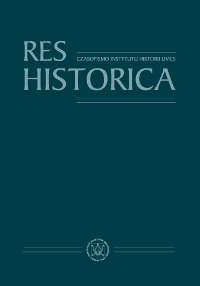Strategies of Historicization of the Presented Cinematic World and Film Narrative in Historical Cinema. An Analysis of the Phenomenon on Selected Examples
Strategies of Historicization of the Presented Cinematic World and Film Narrative in Historical Cinema. An Analysis of the Phenomenon on Selected Examples
Author(s): Piotr WitekSubject(s): History
Published by: Wydawnictwo Naukowe Uniwersytetu Marii Curie-Sklodowskiej
Keywords: visual history; historical film; film narrative; depicted world; staging; historicizing; set design; costumes; language; music; events; characters; makeup; mise-enscène
Summary/Abstract: The article deals with the issue of strategy of historicizing film narrative and the worldpresented on a screen in historical cinema. It shows with what elements the film narrative and the world presented on a screen are historicized. In the introduction of the article, themost important analytical categories such as historical film and strategies of historicizingfilm narrative and the world presented on a screen are conceptualized. Historical film is defined as an operational category requiring conceptualization relativized to a cultural context of its use. A historical film is described as a screening work covering various genological structures, the subject of which relates to the past. The strategies of historicizing the film narrative and the film world presented on a screen are understood as numerous ways. This article focuses on the methodology of studying the reception of historical fiction films by means of press coverage. Although a common practice, it is usually taken for granted without additional methodological reflection. Using the example of three films and their reviews in the Polish press, the article highlights the need to specify the reception’s discursive frameworks on a case-by-case-basis. The political, geographic, or time-related contexts of the historical fiction films significantly modify their modes of interpretation. of equipping the film with various signs of historicity that allow the viewer/researcher to get an impression of the screen effect of a time shift towards the past. In the following parts of the article, the signs of historicity that have the function of historicizing the film narrative and the world presented on a screen are analyzed on the examples of various films covering a wide spectrum of history from ancient times to the present day. The Signs of historicity include the following elements: (1) scenery, stage design, costumes; (2) language; (3) music; (4) characterization; (5) events and characters. Strategies of historicizing the world presented on a screen and film narrative, which have been analyzed in the article, play a particularly important role in the so-called classic films made in the aesthetics of zero style cinema.
Journal: Res Historica
- Issue Year: 2020
- Issue No: 50
- Page Range: 573-604
- Page Count: 32
- Language: English

